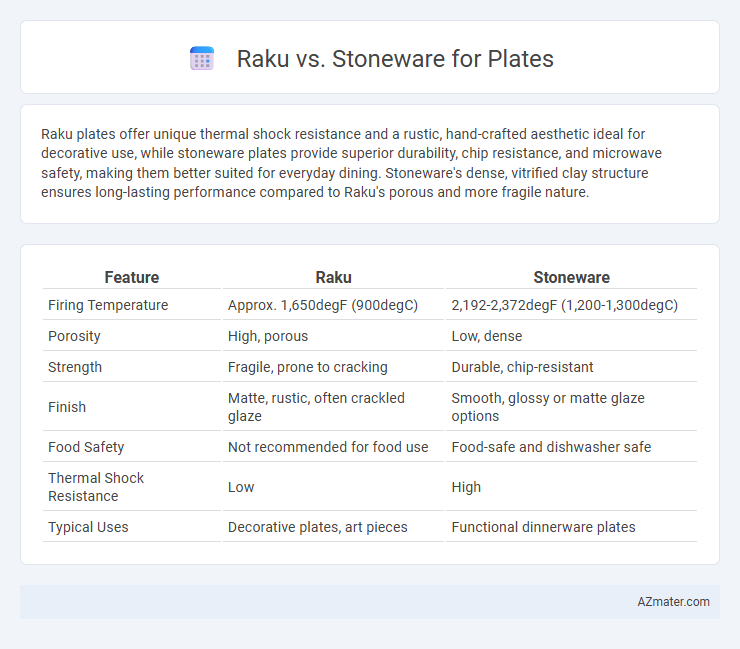Raku plates offer unique thermal shock resistance and a rustic, hand-crafted aesthetic ideal for decorative use, while stoneware plates provide superior durability, chip resistance, and microwave safety, making them better suited for everyday dining. Stoneware's dense, vitrified clay structure ensures long-lasting performance compared to Raku's porous and more fragile nature.
Table of Comparison
| Feature | Raku | Stoneware |
|---|---|---|
| Firing Temperature | Approx. 1,650degF (900degC) | 2,192-2,372degF (1,200-1,300degC) |
| Porosity | High, porous | Low, dense |
| Strength | Fragile, prone to cracking | Durable, chip-resistant |
| Finish | Matte, rustic, often crackled glaze | Smooth, glossy or matte glaze options |
| Food Safety | Not recommended for food use | Food-safe and dishwasher safe |
| Thermal Shock Resistance | Low | High |
| Typical Uses | Decorative plates, art pieces | Functional dinnerware plates |
Introduction to Raku and Stoneware
Raku pottery is a traditional Japanese ceramic technique characterized by rapid firing and cooling, producing unique crackled textures and vibrant glaze effects ideal for decorative plates. Stoneware, a durable and dense ceramic fired at high temperatures, is prized for its strength, chip resistance, and natural earth-tone finishes, making it perfect for everyday use plates. Both materials offer distinct aesthetic and functional qualities, with Raku emphasizing artistry and Stoneware ensuring practicality.
Historical Origins and Traditions
Raku pottery originated in 16th-century Japan, characterized by its hand-shaped forms and rapid low-temperature firing that produces unique crackled surfaces, deeply tied to the Japanese tea ceremony tradition. Stoneware, with roots tracing back to ancient China and Europe, is fired at higher temperatures, resulting in durable, dense ceramic often used for everyday tableware in Western cultures. The contrasting firing techniques and cultural contexts highlight Raku's focus on spontaneity and aesthetics, while Stoneware emphasizes functionality and resilience.
Material Composition and Firing Techniques
Raku plates are crafted from porous clay bodies fired at low temperatures around 1,650degF (900degC) and removed from the kiln while hot, then rapidly cooled, resulting in unique crackled textures and metallic lusters due to rapid oxidation and reduction processes. Stoneware plates use dense, non-porous clay composed of kaolin and ball clay, fired at high temperatures between 2,200degF and 2,400degF (1,200degC to 1,300degC), producing durable, vitrified ceramic ideal for everyday use. The contrasting firing techniques--Raku's rapid cooling versus Stoneware's prolonged high-temperature firing--significantly influence the physical properties, durability, and aesthetic appeal of each plate type.
Aesthetic Differences: Color, Texture, and Glaze
Raku plates showcase unpredictable color variations and crackled glaze effects due to rapid cooling techniques, creating a dynamic and organic appearance. Stoneware plates offer more uniform colors and smooth textures with sturdy, often matte or glossy glazes that emphasize durability and consistency. The tactile surface of Raku contrasts with Stoneware's refined finish, making each Raku plate a unique aesthetic statement compared to the timeless elegance of Stoneware.
Functional Qualities: Durability and Everyday Use
Raku plates, known for their unique crackle glaze and lightweight nature, offer a visually striking option but tend to be less durable and more fragile compared to stoneware. Stoneware plates provide superior strength, chip resistance, and heat retention, making them ideal for everyday use in busy kitchens. The non-porous surface of stoneware also ensures easy cleaning and long-term functionality, while raku requires careful handling to maintain its aesthetic qualities.
Food Safety and Toxicity Considerations
Raku pottery, often fired at lower temperatures and involving rapid cooling, can exhibit porous surfaces that may harbor bacteria if not properly vitrified or sealed, raising food safety concerns. Stoneware, fired at higher temperatures typically between 1,200degC and 1,300degC, is non-porous and generally more durable, reducing risks of food contamination and toxicity. Lead and cadmium content should always be checked in glazes for both Raku and stoneware to ensure compliance with food safety standards and avoid heavy metal leaching.
Raku vs Stoneware: Cost and Accessibility
Raku plates typically come with higher costs due to the specialized firing process and artisanal craftsmanship involved, making them less accessible for everyday use. Stoneware plates are more affordable and widely available, benefiting from mass production and durable materials suited for daily dining. The cost difference highlights Raku's niche appeal versus Stoneware's practicality and accessibility in retail markets.
Artistic Expression and Customization Options
Raku plates offer unique artistic expression through their unpredictable crackle patterns and metallic lusters achieved by rapid cooling and reduction firing techniques, making each piece distinctly one-of-a-kind. Stoneware plates provide broader customization options with varied glazes, textures, and firing temperatures that result in durable, functional, and handcrafted aesthetics suitable for both rustic and modern styles. The choice between Raku and Stoneware for plates hinges on prioritizing either expressive, spontaneous artistry or versatile, practical design customization.
Environmental Impact of Production
Raku pottery involves a rapid firing and cooling process that consumes less energy but often uses chemicals for glazing, which can release toxic fumes affecting air quality. Stoneware production requires longer kiln firing at higher temperatures, resulting in higher energy consumption but typically produces more durable and non-toxic ceramics. Choosing between Raku and Stoneware plates depends on balancing the lower emissions and energy savings of Raku with the sustainability and longevity benefits of Stoneware.
Choosing the Right Plate: Raku or Stoneware?
Raku plates offer unique, artistic glazing with rapid firing, ideal for decorative use but less durable for everyday meals due to their porous nature. Stoneware plates provide high durability, chip resistance, and non-porous surfaces, making them perfect for frequent use and dishwasher safety. Choosing between Raku and stoneware depends on whether you prioritize aesthetic appeal and craftsmanship or practical, long-lasting functionality.

Infographic: Raku vs Stoneware for Plate
 azmater.com
azmater.com